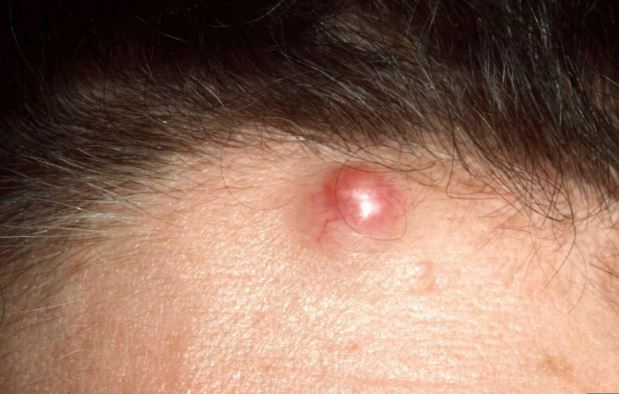Boil and cyst on inner thigh can be painful and irritating. Sebaceous cyst also known as epidermoid cyst may be recurring. Cyst are common in both males and female. A common cause of the cyst is the blocking of the sebaceous glands. Read through to find more about other cause and treatment of how to get rid of the cyst.
Our skin is oiled by an oily substance known as sebum. This oil is secreted by the sebaceous gland, when hair follicles become damaged, they may block the pores. Once blocked, the pores can be clogged with sebum, fluid and other dead skin cells. The damage can be caused by wearing too tight cloths or poor shaving methods. Yeast and bacterial infection can also cause this kind of damage.
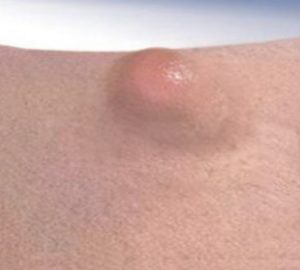
Related articles:
Cyst on Inner Thigh Male
Cyst are common in both men and female. The cyst may also be small or large. Most cyst are smooth and soft when felt by the fingers. The following are some of the causes of the cyst on male inner thighs.
1. Blocked sebaceous glands
Blocking of the sebaceous cyst can be caused by damaging of the hair follicles or the epidermis of the skin around the thigh and groin region. The common cause is poor shaving methods or dry skin in some people.
To prevent this, you need to make sure you are using a sharp razor, apply shaving creams and anti-fungal creams. Also make sure you maintain high levels of hygiene. With a cold compress and avoiding irritating clothes, the cyst will clear up o their own.
2. Bacterial and fungal infection
Bacterial infection as a result of poor hygiene and excess sweating around the groin area is another common cause of cyst on thighs in males. Skin irritation caused by the rubbing f thighs can cause the damaging of the epidermis, the bacteria can sneak in, and cause an infection that damages the follicles leading to formation of painful umps –abscess.
The irritation, swelling and itching can be relieved by use of topical ointments and other home remedies such as apply aloe Vera gel and keep the thighs dry and clean.
3. Wearing tight cloths
Skin irritation and damaging of the hair follicles can also be caused wearing tight cloths that irritate the skin prevent evaporation of sweat. A god example is wearing synthetic underwear. This can cause heat rash, and the damaging of the hair follicles will result in the formation of sebaceous cyst on inner thighs and inside the buttock crack.
Wear loss cotton clothing and maintain high level of personal hygiene to prevent against these kind of bumps.
4. Poor hygiene
Not washing regularly may also lead to the blocking of the sebaceous gland and skin pores. This may cause the skin not to perspire efficiently leading to clogging. The pores may be clogged by sebum, dead cells and blood to form lumps that protrudes the skin, otherwise known as sebaceous cyst.
5. Drug allergy
For some people, the cyst may form as a result of drug allergy. This is due to the immune system causing the over secretion of sebum by the sebaceous gland. This is most common with histamine drugs. Antihistamine drugs can be used to remedy this. Discontinue the use of the drug and seek medical attention.
6. Genital warts
Genital warts, caused by the human papilloma virus a sexually transmitted disease is another possible cause of bumps in inner thigh. It is common in both female and males. The warts will not clear on their own, they are contagious and need immediate medical attention.
7. Cancers cyst on inner thigh
These are malignant cells that will in many cases spread to other parts of the skin. Cancer is chronic, it therefore calls for immediate medical attention. When diagnosed and treated early, there are very high chances of preventing the spread to other parts.
Treatment will depend on the type and stage of the cancer. Treatment include surgery, chemotherapy (where strong chemical medication is used) and radiation therapy which uses high wave ultraviolent rays.
8. Acne cyst on male thighs
Acne an inflammation and infection of the sebaceous cyst is another common cause of red bumps on skin. In males in happens motley during puberty, this is when the sebaceous glands come to life. The growth are stimulated by hormones produced by the adrenal glands in both males and female.
Cyst on Inner Thigh Female
In female the cyst may be formed as a result of hormonal imbalance common during puberty and menstruation. The cyst can also be caused by drug allergy and allergy from body lotion and other deodorants.
Other causes will include, vaginal yeast infection that causes irritation and itching, poor shaving of the bikini area, wearing too tight fitting clothes and poor body hygiene. Heat rash, sexually transmitted infection such as genital warts and cancer are all possible causes of the bumps inside thighs in females.
Cyst on Inner Thigh near Groin Female
For many female it is common for them to experience itchy rash accompanied by cyst and boil. The reason can range from wearing to tight and rubbing clothes that irritate the skin and damages the hair follicle. A damage hair follicle can be clogged with sebum an oily secretion from the sebaceous glands and dead skin cells to form lumps.
Other cause of these lumps includes hormonal imbalance and drug r food allergy. Bacteria and sexually transmitted virus can also cause the development of these boils. Most will heal on their own, you need to keep the groin area clean and avoid tight cloths. Seek medical attention when the boils start to spread too other parts.
Cyst on Inner Thigh Pictures
Here is how a cyst on inner thigh looks like. The size, shape and color may differ depending on the content of the bump.
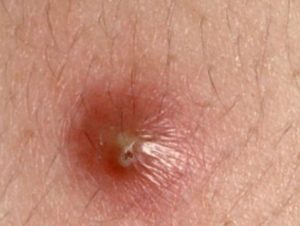
Cyst on Inner Thigh Crease
Cyst on inner thighs will vary on symptoms from person to person. To some people the symptoms will be mild whereas to others the symptoms will be more severe. Unless a cyst is infected or ruptures, most people will not experience pain. Other symptoms will include the size, where some people will have small and other big and large.
In most people crease cyst will often occurs as a result of damaged hair follicles caused by poor shaving methods. The damaged follicles will be clogged by sebum, dead skin cells and other fluids. Alternatively the pores will be filled by pus.
Recurring Cyst on Inside Thigh
What will cause you to have a recurring cyst? It is common for people with diabetes, cancer, weak immune system and HHIV/AIIDS to report recurring cyst on inner thigh and other body parts. Continued skin irritation is a possible cause for this damage. Not maintaining high levels of hygiene is also another way to have an overgrowth of bacterial, fungus and other microorganism causing infection.
Hormonal imbalance, drug allergy, contact dermatitis and wearing inner pants that irritates the skin are also possible causes of a recurring cyst and boils
Cyst on Upper Thigh under Skin
Cyst are common painless lump that can appear anywhere on the skin. On upper thigh, the lumps may feel like large peas under the skin. The main causes of the cyst can include infection, clogging of the sebaceous cyst and skin irritation caused by wearing to tight cloths.
The cyst usually grow slowly, are painless and are smooth to touch when they are rolled under the skin. Unless ruptured or infected or inflamed, the cyst will disappear on their own without treatment. To relieve some of the symptoms of the cyst, the cyst may need to be drained or pop. This should be done by the help of a professional health care provide.
Sebaceous Cyst on Inner Thigh
A sebaceous cyst on inner thigh is a pimple like bump formed when the sebaceous glands become damaged and blocked. The glands are then filled with sebum an oil that keeps the skin and the hair follicles oily. The bumps may also be filled with dead skin cells and tissues. Sebaceous cyst are painless and grow slowly.
A painful lump- abscess, caused by staph aureus bacteria that infiltrate the skin leading to painful, swelling, redness and in most cases a cyst on thighs. This can be clear distinction between a cyst and an abscess bump on inner thighs.
Sebaceous Cyst on Inner Thigh Pictures
Here are some images of how a sebaceous cyst looks like. The size will vary from person to person depending on what is causing the sebaceous cyst. This will include things such poor shaving and wearing too tight clothing that irritate the skin.
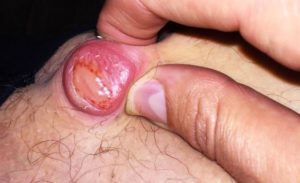
Sebaceous Cyst Inner Thigh Treatment
Below here is how sebaceous cyst on inner thigh can be treated.
a) Topical ointment
Topical ointment such anti-itching, anti-inflammatory and anti-fungal creams can be used to relieve the thighs of the itching, inflammation and fungal infection. In females and kid, the creams will be useful in treating heat rash, diaper rash and vaginal yeast infection.
b) Emollients
Since most skin rash and cyst are due to dry skin, keeping the skin moist and oil is key inn preventing the damage of the hair follicles that causes sebaceous cyst. Topical emollient will help you do that. Avoid over using the creams. Too much oil on skin is so no that good thing.
c) Antibiotics
For cyst caused by bacteria and viral infection antibiotics can be used to treat the infection. The antibiotics can be in form oral pills, topical cream or injectable
d) Draining
For big painful cyst, your doctor may prescribe popping or draining. This can be painful, but if done properly it can be a very effective way to treat the cyst on inner thigh.
e) Surgery
Surgery is the best way to treat cancerous cyst. This will help prevent the spread of the infection to other body parts. Surgery will also help to avoid recurring of the cyst in future.
Inner Thigh Cyst Incision – Video
f) Steroid injection
Your doctor may also prescribe steroid and antihistamine injection to reduce the inflammation and swelling. The injection will also help in controlling the secretion of sebum by the sebaceous gland.
Boils on Inner Thigh and Buttocks
Boils are red, swollen and painful bump under the skin. The common cause of boils is an infected hair follicles. Bacterial from an infected follicle is what forms an abscess- a pocket of pus. As the boil becomes large it may become even more painful.
Other causes of the boils include poor hygiene and yeast infection. Wearing to tight synthetic clothing can also result in the damaging and irritation of the epidermis causing the damage. A common thing with boil and cyst is that you should not pop to drain the cyst. Doing so opens the skin for possible infection.
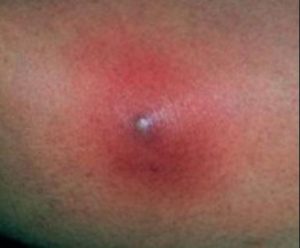
The boils may appear anywhere but is more common around the areas that rubs each other. This will include areas such as buttocks crack, inner thigh, armpits and around the groin area. If the boil cause severe pain or starts to develop on other parts of the body, you need to call a doctor.
Boil on Inner Thigh Female
A boil s an acute infection of the hair follicles. It is also known as skin abscess. Boils are common on inner thigh and any part of the body include face, armpit and buttocks. Bois can be treated at home using simple remedy like keeping your genital clean, applying aloe Vera gel and popping then applying raw organic honey to dry the wound and prevent bacterial infection.
The boil start in the hair follicle, it causes the skin to turn red followed by formation of painful bumps.
How to Get Rid Of Inner Thigh Cysts, Boils – Home Remedies
Apart from medical treatment of the cyst and boil, the symptoms of the cyst can be managed and treated at home. The response of the natural remedy will vary from person to person. If symptoms persist, you need to consult your health care provider as soon as possible.
Try the following remedy.
Aloe Vera
Aloe Vera is a natural antiseptic, anti-itching and anti-fungal agent. When applied on the cyst, the gel will help relieve the skin of the itching and the inflammation. To apply the remedy;
- Squeeze a fresh aloe leave to get the gel
- To get an even more effective remedy, you can mix the gel with honey
- Gently apply the paste on the infected parts of the inner thigh
- Let the paste be for some hours before rinse it off.
Hygiene
Maintaining high level of hygiene will also keep the skin pores open and avoid clogging. Use mild soaps, deodorants and body lotion. If your body becomes allergic to these product, discontinue the use and seek medical attention.
Baking soda
For sores and ruptured cyst, baking soda paste can be used to relieve the itching and pain caused by the inflammation.
Mix a tea spoon of baking soda with lukewarm water to make the remedy. Apply the paste on the infected area. Repeat the process twice or thrice in a day for effective result.
Apple cider vinegar
Another common treatment for bumps and skin inflammation is apple cider vinegar. It contains antiseptic properties that will help relieve the skin of the itching and swelling.
Oatmeal wash
Washing your thighs and groin area with oatmeal water can also help shrink the cyst on inner thigh.
Antibiotics
Over-the-counter antibiotics cream can be used to relieve the thighs of the inflammation, itching and swelling. The antibiotics can be oral pills, injectable or topical creams. Antibiotics can be useful both epidermoid and pillar cyst.
Hydrocortisone
Hydrocortisone are steroid hormone that helps treat inflammation and adrenal failure. When used for sebaceous cyst on inner thigh hydrocortisone may be in form of oral pills or injectable. You need to seek medical attention if the cyst fail to disappear or start to appear in other parts of the body.
Sources and references
- Cyst treatment: http://www.webmd.com/skin-problems-and-treatments/cystic-acne#1
- Cyst and boil home remedy: http://homeremedyshop.com/17-home-remedies-for-sebaceous-cyst/
- Sebaceous cyst: http://www.healthline.com/health/sebaceous-cyst#Diagnosis4
- Cyst lump inside thighs: http://www.webmd.com/skin-problems-and-treatments/guide/cysts-lumps-bumps#1

